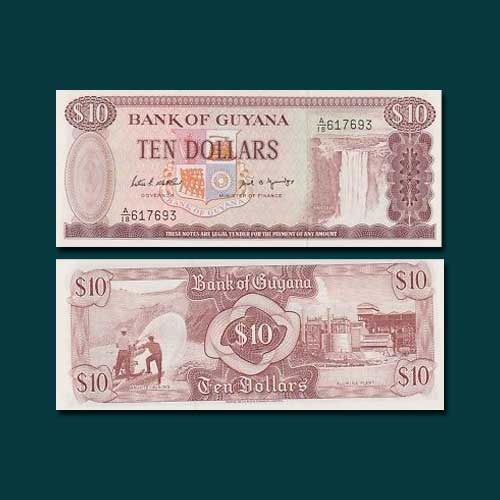Guyana 10 Dollar banknote of 1989
2019-05-18 Sat
Guyana, a country on South America’s North Atlantic coast, is defined by its dense rainforest. English-speaking, with cricket and calypso music, it's culturally connected to the Caribbean region. Its capital, Georgetown, is known for British colonial architecture, including tall, painted-timber St. George’s Anglican Cathedral. A large clock marks the facade of Stabroek Market, a source of local produce.With an area of 215,000 square kilometres, Guyana is the third-smallest sovereign state on mainland South America after Uruguay and Suriname. The main economic activities in Guyana are agriculture (production of rice and Demerara sugar), bauxite and gold mining, timber, shrimp fishing and minerals. The Guyanese dollar has been the unit of account in Guyana (formerly British Guiana) since 29 January 1839.
Private banknotes were introduced in the late 19th century by the British Guiana Bank and the Colonial Bank. Following Guyana’s independence in 1966, the Guyanese dollar was re-introduced. The note depicted beside is Guyana 10 Dollar banknote in 1989.
The note specifications are as follows: The obverse depicts the official Coat of arms; Kaieteur Falls on the Potaro River in central Guyana; while the reverse depicts the Bauxite mining activities; and the Alumina plant. The head of a Macaw parrot is the watermark for this note.
Image Courtesy: PicClick.com
Latest News
-
Janma Kalnayak of Bhagwan Mahavir
2024-04-24 WedOn 21st April 2024 which was the 2550th Janma Kalnyanak of Bhagwan Mahavir Swami, PM Modi unveile...
-
Gold Pagoda of Vijaynagar Empire King Deva Raya I
2024-04-10 WedKing Deva Raya I of the Vijayanagara Empire was a patron of Kannada literature and architecture. He ...
-
Silver Denarius of Septimus Severus
2024-04-05 FriLucius Septimius Severus served as the Roman emperor from 193 to 211 AD. Severus sat on the throne o...
-
Extremely rare 'Malaharamari' type Gold Gadyana of King Guhalladeva-III Sold for INR 611000
2024-04-03 WedTribhuvanamalla, also known as Guhalladeva III, was the ruler of the Kadamba dynasty. His reign coin...
-
90 Years of RBI
2024-04-02 TueOn 1st April, PM #Modi unveiled a special commemorative coin marking 90 Years since the foundation o...

